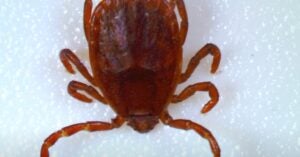University of Missouri Director of Veterinary Extension Craig Payne urges cattle producers to watch for signs of disease associated with Theileria orientalis, a protozoal organism recently detected in Missouri.
This organism, which primarily affects cattle, causes disease by infecting red blood cells. The immune system attacks the infected cells, resulting in anemia.
First discovered in 2017 in the United States, it has been found in nine states, including Missouri. Payne says that as of March 1, 2024, there were six counties in Missouri where cattle have tested positive: Bates, Howell, Oregon, Platte, Shelby, and Webster. The first case was detected in Howell County in the summer of 2023.
With mild infections, cattle may show elevated temperature, depression, and pale mucous membranes. With severe infections, they can show severe depression, and the mucous membranes around the eyes and the vulva appear jaundiced with a yellow tinge. Pregnant animals may abort, and animals will lose their body condition. Payne notes that most infected cattle never show symptoms, and death loss rates are typically less than 5 percent.

Symptoms sometimes confused with anaplasmosis
Payne says the symptoms are similar to those of anaplasmosis. A key difference is that anaplasmosis symptoms are rarely seen in cattle under 2 years old, but symptoms associated with theileria are seen in both calves and adults.
Transmission
The main route of transmission is through the Asian longhorned tick, an invasive species found in 19 states. The tick eats blood meal from an infected animal and then transmits it to other animals through its saliva to other animals within the herd or nearby herds. Other insects, such as lice, biting flies, and other tick species, may be involved in transmission as well.
Blood-contaminated equipment can also transfer the organism from infected to uninfected animals. This would include needles and dehorning, castration and tagging equipment. Up to 10 percent of calves born to infected animals may carry the organism.
Once transmitted, symptoms appear in 1-8 weeks.
Carriers for life
Infected animals will become lifelong carriers of the organism but are unlikely to show symptoms of disease again. Culling these chronic carriers from a herd may be warranted if disease prevalence is low, says Payne.
Management: Treatment, prevention, and control
Antibiotics commonly used to treat and control anaplasmosis in cattle do not appear to be effective against this disease. Recommendations for managing clinical cases include minimizing stress and providing supportive care.
According to Payne, no vaccines are currently available to prevent the disease. The best option is to control Asian long-horned tick populations. Payne recommends a Virginia Cooperative Extension publication on tick management practices for cattle producers, which you can view online.
Payne also recommends quarantining and treating new animals for ticks. In herds where the disease is already present, changing needles between animals and disinfecting equipment that may be blood-contaminated is good standard practice.
Finally, seek guidance from your veterinarian, who can recommend the best strategy for preventing or controlling the disease in your herd, says Payne.


